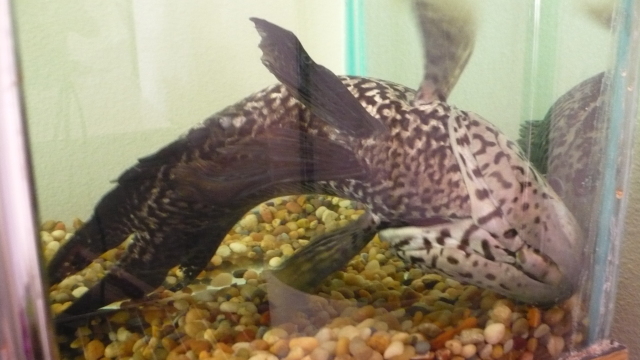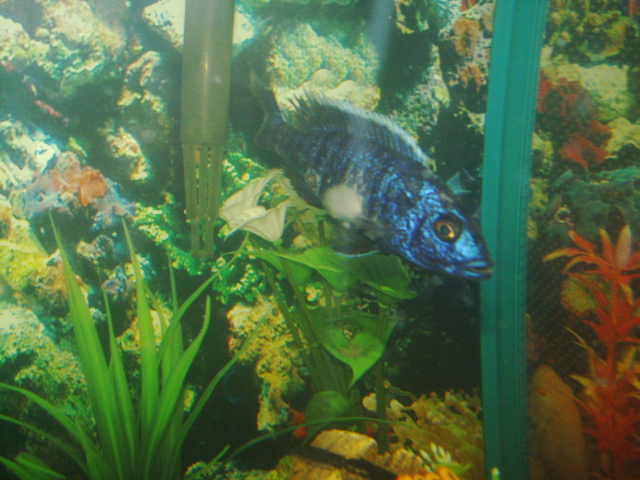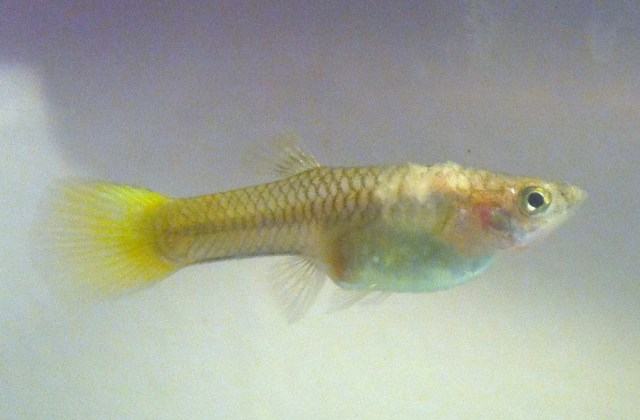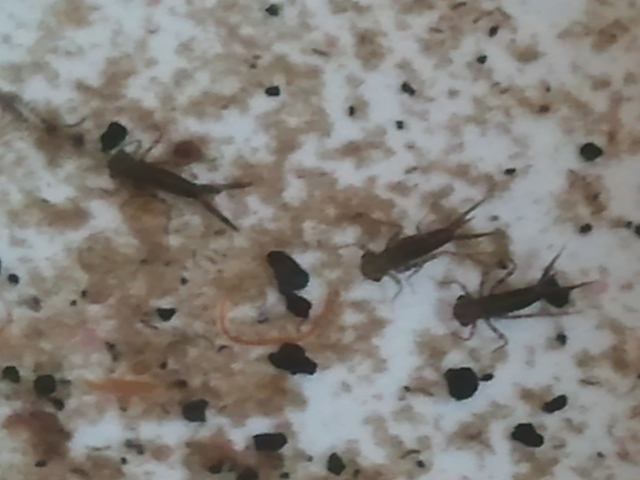QuestionThank you so much! you really cleared things up for me! Also, thanks for recomending that book, "the simple guide to freshwater aquariums". i went out right away and i rented it from the library. and i've already finnished reading it and im gonna read it all over again. i do have a question though-
Would you recomend a swordtail for a starter/cycling fish?
Followup To
Question -
Hi, i'm 15 and am very interested in getting tropical fish, especially a Betta. i bought a 1 gallon tank thinking it would be enough, but now i realize that it would be wise to get a much larger, like a 10 to 20 gallon. i've never had fish before and i would really appreciate it if you could gve me a few pointers on getting a good sized tank and the different breeds that would be easy to keep. i don't really understand the water cycle all that well and i've been searching for a good answer to how you should accually set an aquarium up. the money at our house is pretty tight and i would appreciate your answer to some of my questions. Thanxs.
Sarah
Answer -
Hi Sarah welcome to this wonderful hobby!
You are very correct at getting a 10-20 gal is 100 times better than a 1 gal to start with. A bigger aquarium is best in many beneficial ways... probably the most important reason for a larger aquarium is the large amount of water enables extra room for al error on the aquarists part (example---overfeeding, pollution can't build to the such a terrible level as a small 1 gal can in a matter of 24 hours.)
Ideally I would recommend you start with a 20 gallon. This size will also allow you to keep more species of fish!
But you can make it with a 10 gallon. This is the size nearly all aquarists start with in the beginning. In fact, this was the size I started with!! But I don't recommend it because I have found that in the past, it is typically just too small to start with.
Letting the Aquarium cycle is the most important thing you can do when you first start out. I hope I can help you understand this better--
Basically cycling means allowing your aquarium time to establish a special bacterial colony which are often just called "beneficial bacteria" these beneficial critters consume ammonia--which is a product of fish waste and respiration. Ammonia is extremely toxic to all fish and aquatic creatures and without these bacteria, no aquarium could stay healthy longterm. These bacteria convert ammonia into nitrite which is still toxic but not as bad as ammonia. Nitrite is later converted into nitrate by more bacteria. Nitrate is the end product of the cycle and is the very least toxic of them all. Nitrate is removed by your maintaince water changes.
Allowing your aquarium to cycle requires the addition of a food source for your bacteria to develop. This means the addition of a hardy fish or "cycling" fish. There are a few species that are hardy enough to withstand some of the polltuion that comes with tank cycling better than others.
My top favorites are Black skirt tetras, Platies, Zebra Danios, and a few others. These fish are proven hardy cyclers, but of course you must never subject them to high ammonia or nitrite. Even the hardiest fish can't handle the toxic ammonia in an uncycled aquarium--one that is just setup and that is a very good reason to start with ONLY a few fish and not a whole tankload.
For a 10-20 gallon- 1-2 black skirt tetras or platies is enough. Zebra danios should be kept in groups of 3 at least at all times--they need to be a group.
Before we get into cycling we must cover what we need for an aquarium first off--
List of needed supplies-
* Tank and Stand
* aquarium test kits for ammonia/nitrite/nitrate
* Cover and florescent light hood
* Gravel- 10 pounds is plenty for a 20gal
* Filter- HOB (Hang on back power filters are the best for beginners and work wonders!)
* Heater + aquarium Thermometer (if you live in a quite temperent climate with very cold winters--a heater is vital. A good brand like Visatherm is best.)
* Decor and plants ( your choice, live plants can be a bit of a hassle in the beginning so you are best stick with plastic for now)
* ICK medication (this isn't entirely vital. But Ick medication for treating white spot (also know as ICK) is good to have on hand because of the such common occurance this parasite can appear with new tanks...
* Aquarium siphon hose and Bucket- for water changes
*Water conditioner- for dechlorinating your tap water from harmful chlorine and chloramine which is toxic to fish.
*Good quality flake food of course! For your average tropical fish, high quality flake food is best. Omega ONE is an excellent brand.
As you can see the list isn't all too long. Aquarium keeping can be a little pricey in the beginning. But once you get everything setup. Your purchases should only have to be more water conditioner every so often--maybe once a once. And fish food at about that same rate but it's difficult to determine of course. And if you start with good quality equiptment, you won't have to go back and spend more money on replacement filters/heaters ect...
Your first step is deciding where to put your aquarium. It should be in a place somewhat out of the way, but where it is easily viewed and seen nearly all the time. It should be away from AC and heaters to avoid overheating or chilling in the summertime. And also where you can easily plug in the filter/heater and light.
Be sure to set your aquarium far away enough from the wall where you can fit your power filter behind the tank.
Wipe the aquarium's inside with a damp paper towel (never ever use any chemicals or soap with anything that goes into your aquarium water.)
Next rinse and add your gravel. An inch layer is enough for non-planted aquariums. More gravel and you can have problems with the gravel becomming excessively dirty and clogged. Now fill fill your aquarium 1/3 full of water. Now you can set your decor and plants in place. Try to make little bunches of plants so your fish will feel more secure with a hiding spot. Next fill the aquarium the rest of the way, now set your power filter and heater in place. DON'T plug in your heater or filter right away!!!!!! Your filter needs to be primed with aquarium water by pouring some in until the water overflows out the waterfall part. Your heater needs time to adjust to the aquarium's temperature before being plugged in. This only takes about 20 minutes. Then you can plug both in. Your filter will make some pretty weird sounds before it will run smoothly and quietly. Next place your protective glass cover in place and your hood on top of that fitted correctly.
((ADD water conditioner! It's best to add a little more than the directions say on the bottle. Some water companies add more chlorine/chloramine at certain times of the year))
Now you have all equiptment in place and your aquarium thermometer on the front/side of your aquarium you are almost ready for fish. I have had excellent luck in allowing a new aquarium to sit and run for a week at least before adding fish. This allows for the heater to begin working properly and the new water to age a little.
Now you are ready for fish! If you love color and lots of activity, platies are your best bet for cycling. But the noble Black skirt tetra (althought some say he's plain) is my best cycling fish ever. You can keep these guys alone for a while to be careful not to overload your bacteria and have a fish wipeout. But they love having friends so it's better to be sure and add more once your aquarium has cycled. Platies can be OK alone, but I feel they need another for company even during cycling. They are pretty small fish and a pair of them won't hurt.
Hurry your new fish home and turn out their aquarium light before floating them (the light can give off heat and warm up the bag water to higher than the actual aquarium water)
Float their bag for 20-30 minutes then take their bag out of the water and set it into a 1 gal pitcher with no soap residue. Now add half a cupful of aquarium water every 5 minutes. Do this until your 1 gallon pitcher is just about full. This sounds odd I know but this insures your fish are properly acclimated to your aquarium water's chemistry slowly and avoids a sudden shock many fish experience from just being floated. After your pitcher is just about full, use your aquarium net and carefully net out the occupants and gently release them into your aquarium. Now they should be very happy to be carefully adjusted to your new water from the store water. Just dump the pitcher water out. It's no good with the store water. Give it to plants.
Now comes the hard part of cycling. Once the addition of a ammonia source is made, your aquarium will slowly begin to grow bacterial colonies. Often for the first few days you will experience a ammonia spike which is very harmful to your fish, but just a normal part of cycling. Some people never have this happen but don't worry too much of it does, just immediately do a 30-50% water change with your aquarium siphon and bucket. ALWAYS make the replacement water equal to that of your aquarium's with the use of your thermometer. And always dechlorinate it.
~Test your water every day for ammonia, nitrite and nitrate. If ammononia and nitrite are above safe bounds, do a 30-50% water change.
~Feed your fish VERY lightly. one flake per fish once a day is more than enough. They are naturally adapted to small amounts of food infrequently in the wild. They won't starve.
~ Don't add anymore chemicals or additives to your aquarium water than your normal water conditioner.
~ Don't worry too much and ENJOY! Cycling is no big deal as long as you test your water for ammonia/nitrite every day and make those neccesary water changes if the levels are above safe bounds.
~*~Your ammonia levels will rise high then gradually begin to decline--while your nitrite rise and then slowly begin to decline. When your ammonia and nitrite have dropped to zero and nitrate have risen in their levels your aquarium has cycled!!! Now you can feel safe adding a few more fish. But still not too many. Aquarium keeping takes lots of patience but it's not too hard to get through the cycling.
Usually it takes about 4-6 weeks for your aquarium to fully cycle.
Be sure to test after every new fish addition to insure you haven't overloaded your bacterial colony which needs time to grow and adjust to the new load of bio waste put to them.
With time things won't seem so hard and confusing. Everybody who has kept fish for years has gone through this.
There are many species whom would be suitable for a 20gal aquarium. My very best advice is ALWAYS research any new species of fish before buying him. Too many people make the mistake of buying a unsuitable fish for their aquarium that grows too large or has special water requirements than they can provide and the end results are sad.
Always research beforehand!
Keep up with frequent partial water changes and careful feedings and don't overstock and your aquarium will be happy and healthy for years to come!
Well, before I write a mininovel, I really hope this helps!
Remember, if you have anymore questions, feel free to email me.... Thank you for taking the time to read all this. I know you must care very well for the little creatures with no voices. I'm glad you consulted me before getting into the hobby!
(Bettas are great fish. But I really don't recommend keeping them in that small of an aquarium. Bettas are special fish that require a bit different requirements than other fish and contrary to popular belief, can't and don't like to live in stagnant bowls/vases/ or cups. Because most people like to have a community of fish--and bettas can't always live peacefully with other species. It might be better for you to start with a medium size aquarium with several species of fish and gain some experience with fishkeeping with them. Then setup a aquarium just for a betta) ;-)
My very best wishes and Happy fishkeeping!
Karen~
PS: please look into this best beginner book of all time--
" The simple guide to freshwater fishkeeping"
this will really help you out!
AnswerHello Sarah! I'm very glad to hear how much I've helped you out! Thank you for your nice comments! I'm very glad you looked in the "The simple guide to freshwater fishkeeping" It's the best book i've read so far for beginners especially.
~Swordtails should be hardy cyclers. Of course you should never subject any fish-- no matter how hardy, to high ammonia or nitrite levels. I love swordtails, but my all-time favorite fish for cycling is Black skirt tetras.
Swordtails work just lovely. Try to keep only one male per tank--they tend to fight. A trio of one male per two females works fine.
Well, I really hope this helps! As always feel free to email me if you have anymore questions....
My very best wishes and I hope you get into and enjoy the hobby as much as you can! Best of luck!
Happy fishkeeping!
Karen~

 Swim Bladder Problem
Question
Buttnippers Problem
I have an 8 yr old Manguan
Swim Bladder Problem
Question
Buttnippers Problem
I have an 8 yr old Manguan
 cichlid infection?
Question
Cichlid injured
one of my cichlid fish was bul
cichlid infection?
Question
Cichlid injured
one of my cichlid fish was bul
 Sick female guppy
Question
Guppy fish
Hello, I am new to fish breeding an
Sick female guppy
Question
Guppy fish
Hello, I am new to fish breeding an
 Found brown bugs in my filter!
Question
Bugs in tank
I cant find this answer an
Found brown bugs in my filter!
Question
Bugs in tank
I cant find this answer an
 unknown fish
Question
Unknown Fish
I got 3 fish from a friend, but d
unknown fish
Question
Unknown Fish
I got 3 fish from a friend, but d